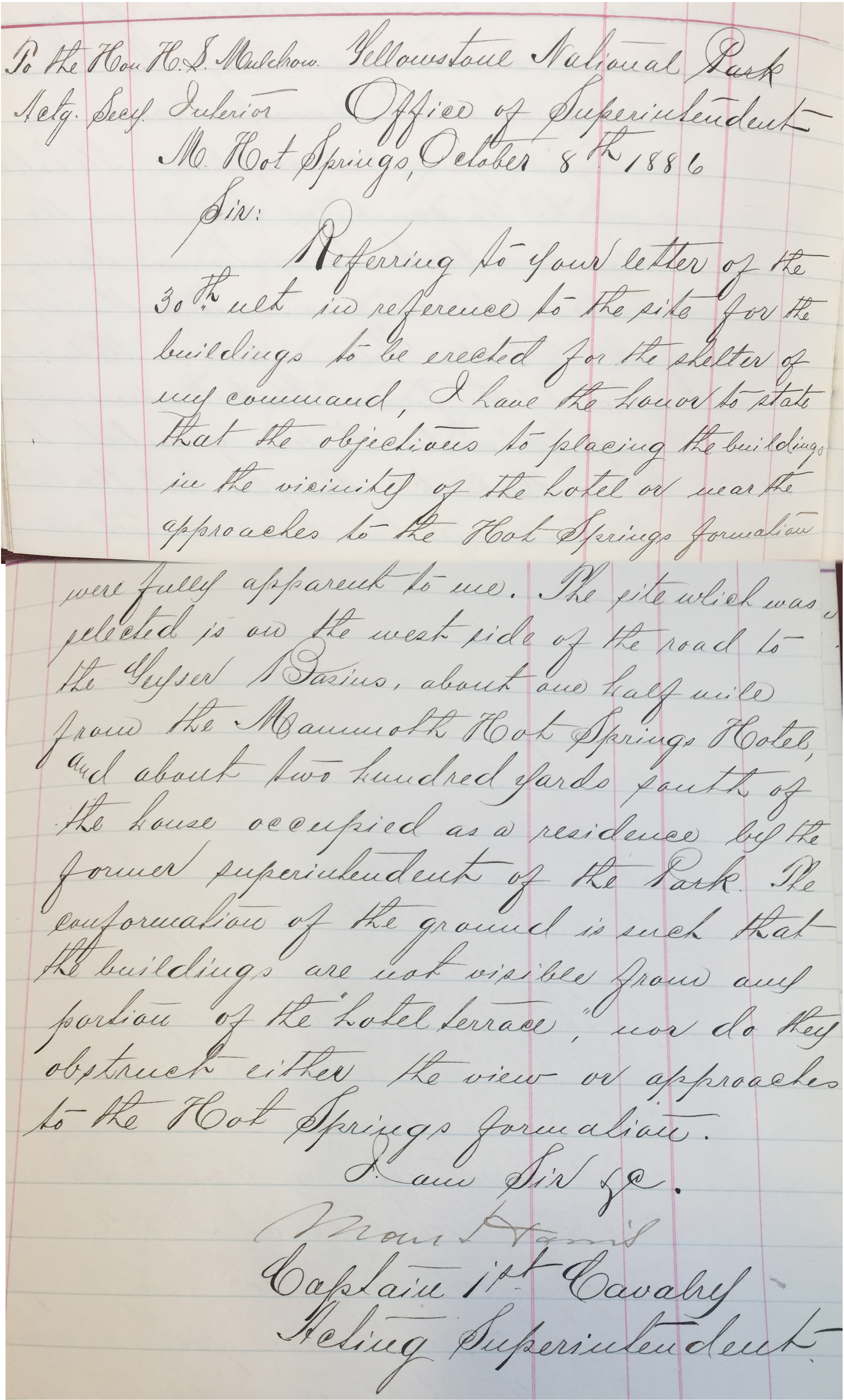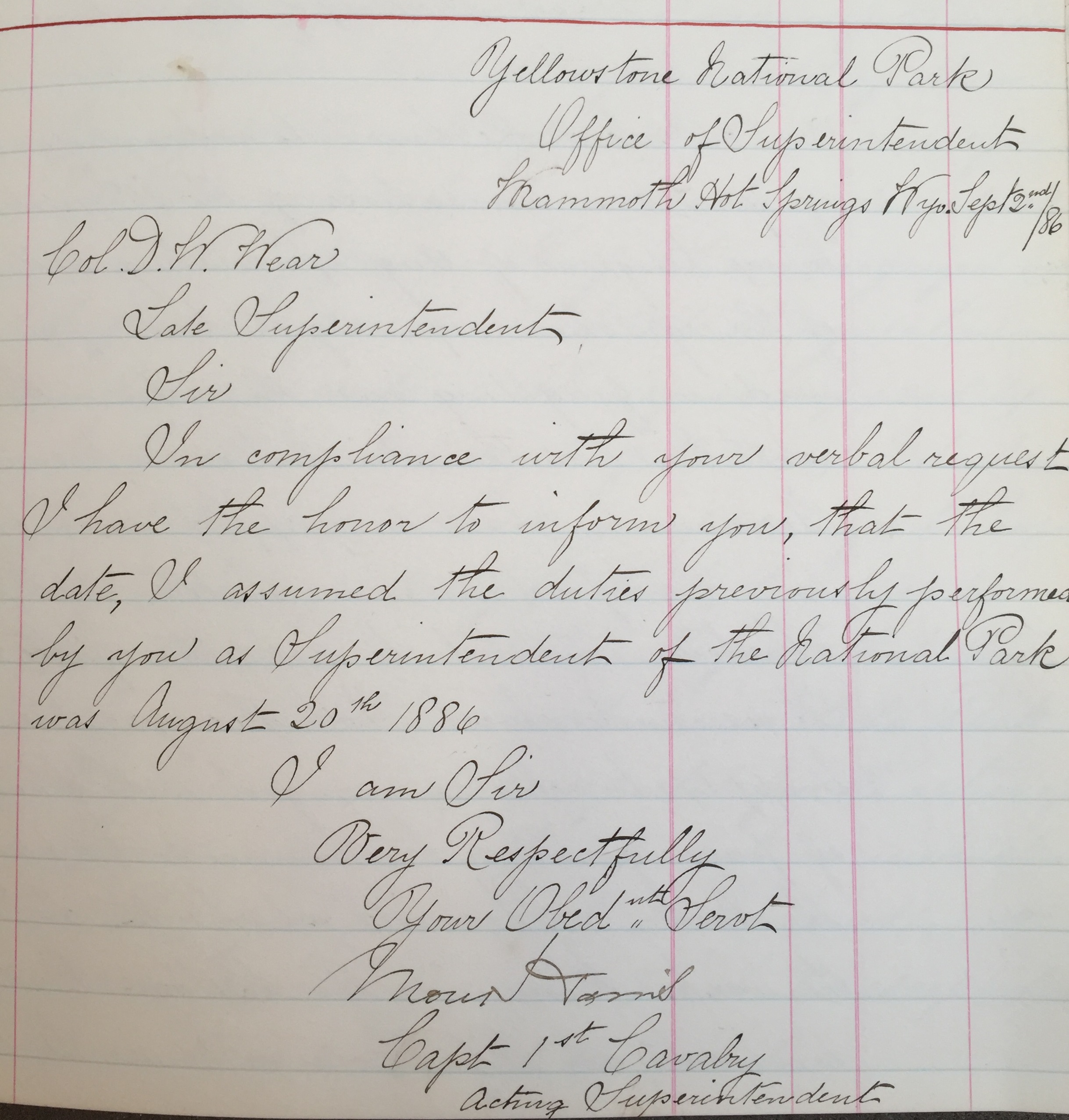The suggestion to use the military of the United States to protect Yellowstone was first made in 1875 by Captain William Ludlow. Following a 13-day expedition through the park in August 1875, Captain Ludlow noted in his official report two issues that plagued the park’s natural wonders and resources: vandalism and wildlife slaughter. If the United States Congress would not act to protect the park, Ludlow proposed that the control and protection of the park be transferred to the War Department. He wrote, “It would certainly be most convenient and expedient to take advantage of the presence and organization of the military…at least until such time as a Civilian Superintendent, living in the Park, with a body of mounted police under his orders, can suffice for its protection.”
In the Report of the Superintendent of the Yellowstone National Park to the Secretary of the Interior, August 20th, 1886, Superintendent D.W. Wear wrote,
Congress having failed to make any provision for the pay of the Superintendent or his assistants or for the protection of the Park, I was notified on August 14, by telegram from the Secretary of the Interior that he had called upon the Secretary of War for a detail of soldiers to do duty in the Park, and that Capt. Moses Harris’s Troop M, First United States Cavalry, would arrive in a few days…On the 17th of August Captain Harris, with 50 men of Troop M, First Cavalry, arrived in the Park.
Captain Moses Harris, Troop M, First United States Cavalry, became the first acting superintendent of the period that would later become known as the “Army Era” on August 20th, 1886. He served in that position until June 1st, 1889.
From the first day of his tenure, Captain Harris used his position to establish “respect for [the park’s] rules and regulations.” He expelled violators and attempted to curb the commercial interests that were spreading rapidly through the park. For example, on August 21st, the day after he became superintendent, he issued a circular stating, “The practice of turning stock loose to graze in the vicinity of the various objects of interest in the National Park…will, from this date be discontinued.” Additionally, he stationed troop detachments at all of the locations that had been occupied by assistants of the civilian superintendents.
His job was not easy though. As had been the case with the previous administrations, Captain Harris did not have much support from the Department of the Interior or the United States Congress. He was constantly looking for the promised guidance of the Secretary of the Interior and funds to manage the park. In a letter dated January 12, 1887 and addressed to Assistant Secretary of the Interior Henry Muldrow, Harris argued that any revenues the park produced should be returned to the park by the Department of the Interior, which had been a provision in the congressional act that created Yellowstone in 1871. On this instance, he needed funds to establish a suitable headquarters for park officials. He wrote, “It is of the first importance to the proper management of the Park that the Superintendent or person acting as such be provided with an office in which to transact the public business with decency, and with regard to the convenience of the public.” According to the letter, when Harris arrived, he found the office of the superintendent located in an old blacksmith shop, “built of rough boards full of wide cracks,” “totally uninhabitable during the winter,” and so “squalid a character that it was humiliating to have to transact business in such a place.” By the time the letter was written, Captain Harris had removed all the records from the office and set up a temporary office space in his residence, which was also in terrible condition.
Despite all of the funding issues and the management problems he and his troops had to deal with, Captain Harris performed his duties admirably and set an important precedent for all those that would follow him and hold the office of Superintendent of Yellowstone. Famed US Army Engineer Hiram Chittenden wrote, “The Park was particularly fortunate in its first military superintendent… He was vigorous and uncompromising in suppressing lawlessness, just and impartial in his rulings, untiring in his watchfulness for the public interest.” In 1886, Yellowstone needed a man of discipline and strong principles in order to survive. Captain Moses Harris, Troop M, First United States Cavalry, was that man.

Direct Quotation Sources:
-Captain William Ludlow, Report of a Reconnaissance from Carroll, Montana Territory, on the Upper Missouri to the Yellowstone National Park, and Return, 1886, page 37
-D.W. Wear, Report of the Superintendent of the Yellowstone National Park to the Secretary of the Interior, August 20th, 1886
-Aubrey L. Haines, The Yellowstone Story: A History of Our First National Park, vol. 2, 1977, page 453
-Captain Moses Harris, “Letters Sent: 1886-1887” Bound Volume, in Box 022, Series I, Record Group 00, Army Era Records, Yellowstone National Park Archives
-Hiram Martin Chittenden, The Yellowstone National Park, Historical and Descriptive, 3rd ed., 1900, page 138 (Chittenden removed this description of Harris before the 4th edition was published in 1903, it was not added back until Chittenden’s work was edited by Richard A. Bartlett and reissued in 1964)
Photos:
“Harris Blog Photo 1” A letter written by Capt Harris to D.W. Wear on September 2nd, 1886
“Harris Blog Photo 2” A letter written on October 8, 1886 by Capt Harris to Henry Muldrow, who was acting secretary at the time, describing the area near the Mammoth Terraces which was chosen as the site for the buildings of Camp Sheridan, later Fort Yellowstone.

